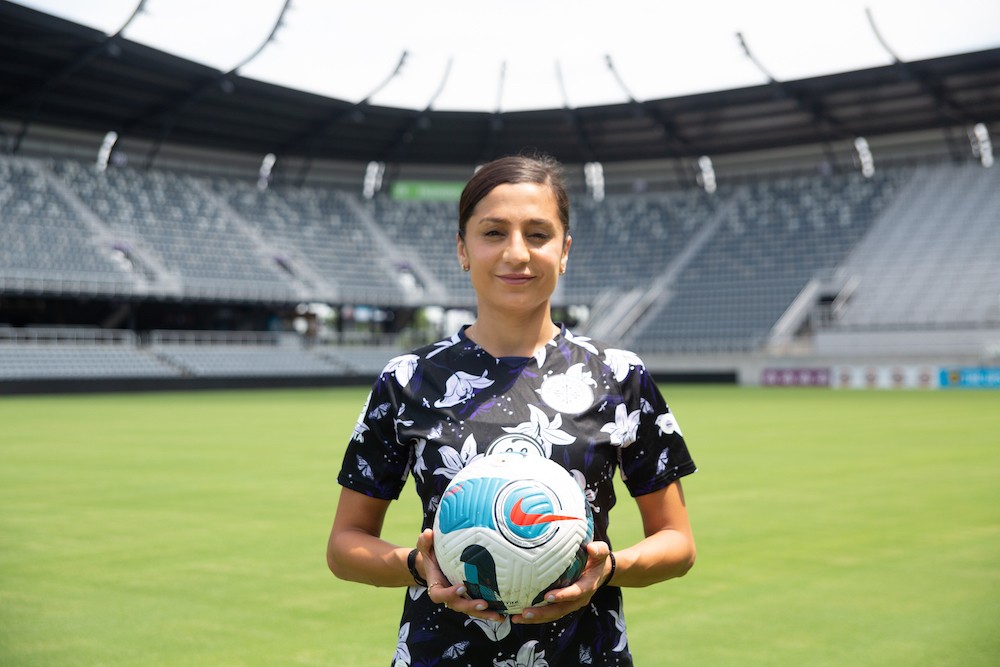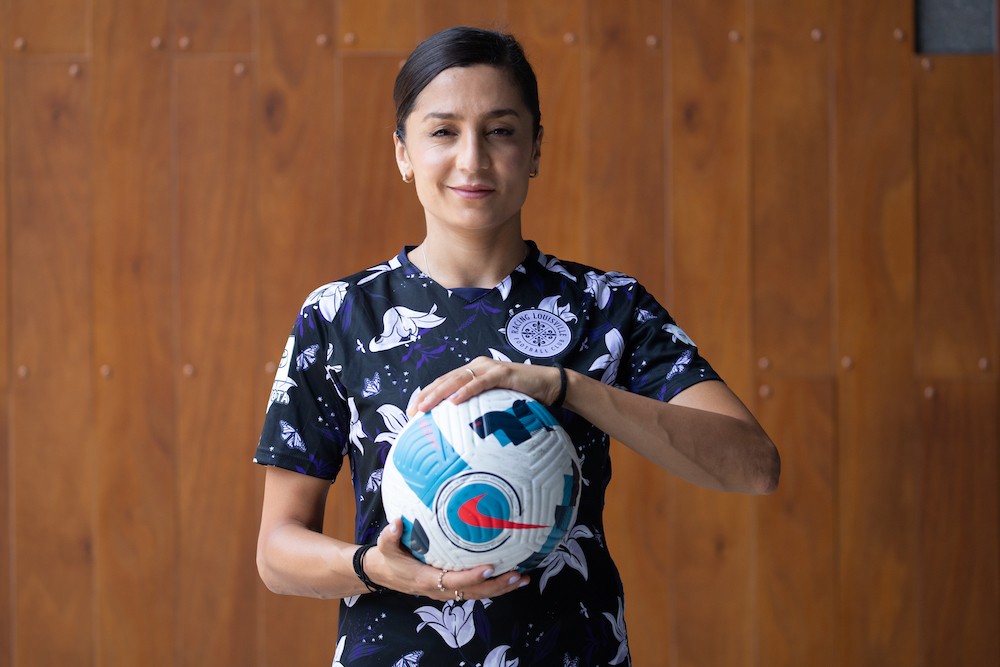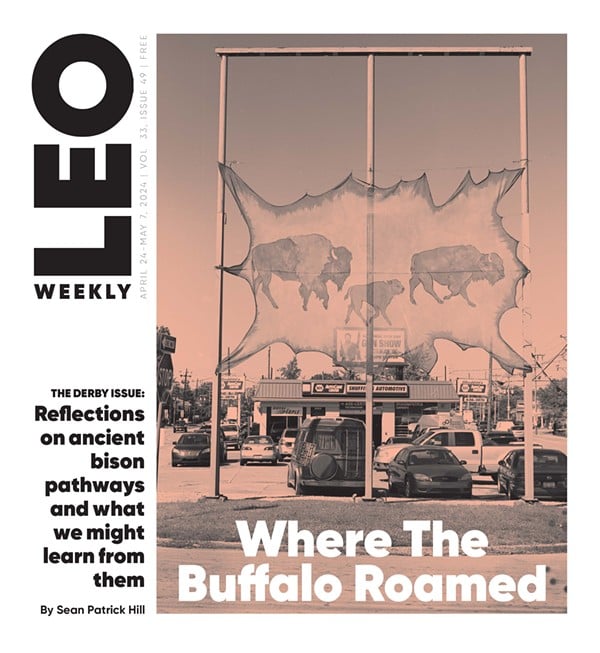It was the kind of moment she had dreamed of as a child refugee in Denmark first learning soccer: Just four minutes after she took the field for the second time of the 2022 season, Racing Louisville striker Nadia Nadim, M.D., was squaring up for a penalty shot.
The little time she had spent on the field since being substituted in during the 61st minute had already been eventful, with Nadim taking a close-quarters shot off of a rebound just seconds after she entered the game to the crowd’s most thunderous cheers of the night.
That shot was blocked by a defender, but after Racing midfielder Savannah DeMelo was flattened in front of the goal just over a minute later, Nadim was called forward to take the resulting penalty shot. The 34-year-old Afghan-born forward now had another opportunity to score her first goal since tearing her ACL in a potentially career-ending injury last September.
Before she came into the game, Nadim had found a distant spot on the sidelines to warm up alone after former Angel City FC midfielder Savannah McCaskill netted a goal a minute into the second half giving the visiting team a 2-1 edge. From the upper deck of Butchertown’s Lynn Family Stadium, it looked like Nadim was annoyed and impatient as she, like the fans, was relegated to the role of powerless spectator.
Lined up for the penalty shot, Nadim stared in at the goalie, who clapped her hands above her head and moved from side-to-side in her 24-foot-wide domain. In the standing room only section behind the goal, the flags of Black Lives Matter, gay pride, Nadim’s adopted nation of Denmark and the embattled nation of Ukraine were hanging from the rails alongside a banner depicting a protest fist between two ovaries.
The Taliban, which Nadim escaped as a child, would not have approved of the scene: Not of the shorts she was wearing or her uncovered hair; not that she was an educated, independent woman; not that she was a professional athlete; not of the flags in the stands or the fans sipping Modelos.
Nadim surged forward and struck the ball with her right foot. The goalie went right. The ball went left, finding the back of the net.
Nadim had her first goal of the season, tying the game for Racing. Purple and white smoke filled the air.
As the defeated goalie walked towards the ball where it had come to a rest, Nadim ran forward at the net, gave a triumphant leap and snatched up the ball (later, on a podcast, she’d say that she felt irritated and provoked by the goalie before the shot and decided to “irritate her back.” As she unboxed a new pair of cleats in one of the stadium’s luxury boxes in July, she’d tell me that she enjoys situations where there’s more pressure than usual).
At the far end of the stadium, in the supporters’ zone where chants keep going the entire match, the words on a red and white Danish flag that began the match reading “THE DR. IS OUT” now read “THE DR. IS IN.”
A career that started as a child practicing with deflated balls in a Danish refugee camp had taken Nadim to some of the top women’s soccer teams in the world, eventually landing her in Louisville, where she has tried to help a young club that continues to struggle in the standings. The torn ACL kept her off the field, limiting her ability to do that. But for a person who continually had to overcome adversity, the painful injury was just a bump in the road.
“I’m not really a person who gets scared of things,” she says. “I accept things the way they are. That makes my life a lot easier.”
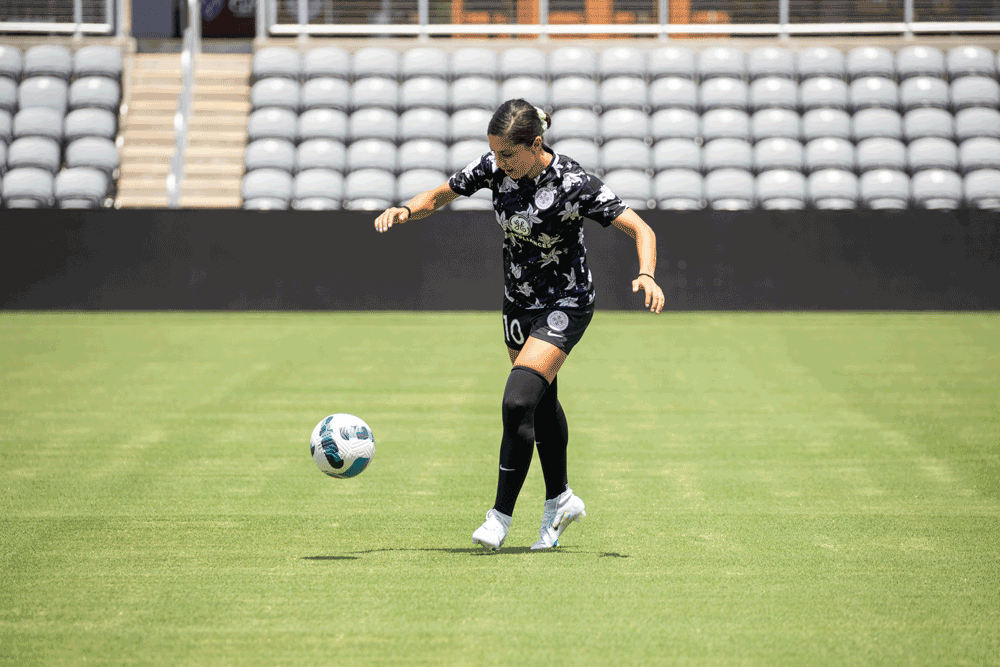
The Most Important Goal
More than 100 caps (international games, in soccer talk) for the Danish national team. A French league title with the historied Paris Saint-Germain Féminine. The top scorer on the Portland Thorns FC when the team finished with the best record in the National Women’s Soccer League in 2016.But the goal Nadim holds dearest didn’t come under towering stadium lights in front of thousands of adoring fans as she played on the highest stages of women’s soccer. Instead, it came on a more humble pitch (field, in soccer talk) as a young Afghan refugee newly arrived in Denmark after escaping Taliban rule in her homeland.
On a rainy day when she was 12 or 13 in the early 2000s (she can’t recall exactly when), Nadim was playing in her first championship, a regional affair. She had only been in Denmark for a short time — and had only picked up soccer after her arrival in Scandinavia — but had already established herself as a talented player.
Her team was the underdog going into the seven versus seven championship match. But with her team trailing, Nadim scored a hat trick to hand them a 3-2 victory.
For her culminating goal, she faced a defender one on one and then “smash[ed] it, upper 90, opposite long corner.” (In non-soccer speech: the far, opposite corner of the goal, a location where it is very difficult for a save to be made).
After that goal — still her favorite — she did a flip and almost hurt her back.
“It was such a big moment for me and my teammates. Everyone just like lost their shit,” she says.
Nadim had never experienced soccer until after she arrived in Denmark with her mother and four sisters two years earlier, smuggled in the back of a truck from Italy after flying to Europe on forged documents. The first refugee facility they were brought to, the Sandholm Asylum Center outside the Danish capital of Copenhagen, felt like a prison to Nadim; there were guards and barbed wire and they couldn’t leave. But after they were processed, Nadim and her family were moved to a refugee camp in Visse, a town just outside of Aalborg, Denmark’s fourth-largest city, in the far north of the country.
The accommodations in Visse were sparse, with refugees living in shared prefabricated buildings. But it offered safety, community and a chance for Nadim to just be a kid again after fleeing Afghanistan, where Nadim had seen war and death and been forced into hiding with her family once the Taliban took over and killed her father, a general in the Afghan National Army.
“It was really minimal,” she says of the Visse refugee camp. “But I didn’t really care. It was safe. And we were together.”
In the camp there were refugees like Nadim’s family from all over the world: Iraqis fleeing Saddam Hussein’s ego-driven dictatorship; Somalis escaping chronic instability in their homeland; and fellow Afghans fleeing the Taliban.
A soccer club practiced near the refugee camp and Nadim and other refugees acted as “ball boys” chasing down and returning wayward soccer balls that flew off the field during shooting drills.
The pitch was bounded by woods and one day, Nadim talked her friends at the camp into searching the woods for balls that might not have been found. After what she describes as a systematic search of the woods, they came out with more than 20. Some were in poor shape and deflated from spending years out in the elements. But others looked brand new.
“I was feeling a bit uncomfortable with having those balls because I was like, ‘If they see us, they’ll think we stole them.’ So we went back to the club and said, ‘these are the balls that we found,’” she says. “And the guy took the best ones, but left the ones that deflated for us. But we were still super happy, because it was like, ‘Ahh shit! We got some balls!’”
Once they brought the battered balls to a gas station and figured out how to use a tire pump to inflate them, they were able to play soccer.
Through soccer, Nadim was able to find her footing in a foreign land. It helped her learn the language (well, curse words came first, then soccer vocabulary) and become accepted in Danish society. But she was still clawing her way from behind, learning a new language and a new sport alongside children who had spent their whole lives knowing both. But that kind of adversity took the form of a competitive challenge in Nadim’s mind.
“I was behind when we arrived in Denmark and I felt like I needed to catch up. So if you think it’s a race, everyone else has been given a head start… it’s a 100 meter race and they’re already 60% of the way there,” she says. “That’s kind of been my drive and my family’s drive in general: to catch up, learn a language as fast as possible. Get smart as fast as possible. Get good at football and make something of your life because you never ever want to feel so helpless again.”
From The Beginning
Nadim was born in 1988 in Herat, in the far-western reaches of Afghanistan near the Iranian border. However, her father was in the Afghan National Army so her family moved around. She ended up spending most of her early life 500 miles east of her birthplace in Afghanistan’s capital Kabul, a city that was once a major waypoint on the ancient Silk Road and later the trans-continental Hippie Trail that in more recent decades has been a byword for conflict and occupation.To Nadim, her childhood felt like two very different movies.
In one, she felt safe and secure, growing up “probably on the wealthier side of society” in a heavily-guarded Kabul neighborhood.
The second, when the Taliban took control, was like a horror movie.
“A lot of moving around. A lot of not knowing what’s happening. You saw things as a kid like you’re not supposed to see,” she says. “I’ve seen dead people. I’ve drove past places where you saw just… blood.”
Through the ‘80s and early ‘90s, Afghanistan was dominated by war, first between the Mujahideen and the Soviet Union and later, after Moscow called their occupation quits in the land called “the graveyard of empires,” civil war.
Afghanistan knew war and hardship, but the 1990s saw the emergence of the Taliban, a group of hardline Islamists with little tolerance for those who strayed from their interpretation of Islam. Fighting intensified around Kabul and in 1996, the Taliban captured the capital.
A former president of Afghanistan, who had headed a Soviet-backed government in the early 1990s, was killed, with Taliban fighters dragging his body behind a truck through the streets before hanging it from a lamppost. Music was banned, as was television and sport. Women were not allowed to work or study and were required to cover themselves from head to toe. Minorities were persecuted. Those who ran afoul of the stringent rules were beaten or killed.
With sports banned, the extremists turned Kabul’s soccer stadium, Ghazi Stadium, into a venue for public executions, shooting kneeling men and women on the field. Footage smuggled out of the country that showed a woman in a blue burqa being executed with a Kalashnikov on the lines of the penalty area in 1999 served as an iconic image of the Taliban’s brutality.
After the Taliban had entrenched itself, Nadim’s father was called to a meeting with them. Her family would later be informed he had been taken out into the desert and executed. They never received a body to bury.
With her father dead and the Taliban in control, Nadim’s family went into hiding, moving from place to place and eventually fleeing to the countryside. Nadim stopped going to school. Her mother stopped working.
“Basically just trying to survive, I guess, and see what tomorrow’s going to bring. Is it going to get better? Is it going to get worse?” she says. “It was just hiding, staying low, staying put.”
There was no future for them in Afghanistan anymore, so Nadim’s family fled. First, they went across the border into Pakistan. Then, with pre-9/11 airline checks nowhere near as stringent as they would become, they were able to use forged documents to fly to Europe.
From Italy, where they landed, her family was smuggled overland by truck. They were trying to get to England, where they had family, but then, like now, those being smuggled often have little control over their final destination.
Today, more than two decades after she left her homeland, Nadim is a monument to everything the Taliban was trying to strip from Afghan women.
She is educated, speaking eight languages (Hindi, Urdu, Persian, Dari, English, French, German and Danish, while understanding Pashto, Swedish and Norwegian) and earning her medical degree last year (which she pursued while playing soccer professionally).
She is outspoken. She is uncovered. She plays sports.
In the eyes of the extremists she escaped, everything about her would be a sin.
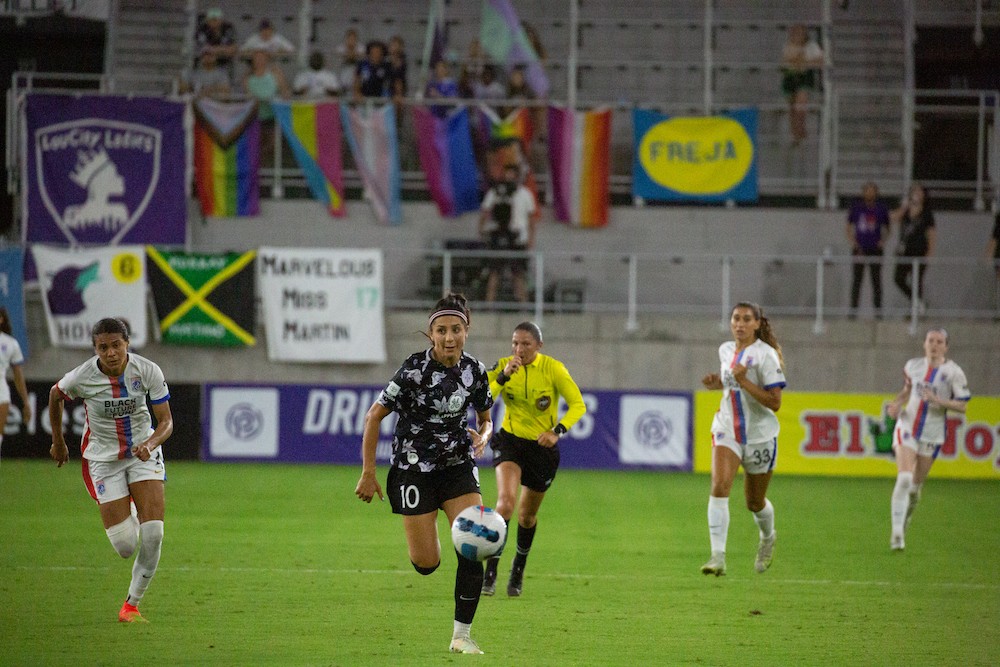
Walk The Talk
Last September, Nadim was just a month and a half into her Racing career when the team headed to Florida to take on the Orlando Pride. Nadim had been named to the NWSL’s “team of the month” for August and netted three goals for Louisville, giving the team hope in its rookie season.Just 12 minutes into the Sept. 11 game against the Pride, Nadim was taken down by a tackle as she went to intercept a pass. She fell to the ground, writhing in pain before she was carried off in a stretcher. Days later, Racing would say her ACL was torn and her season was over.
“I’ve never felt anything like it pain-wise. I think the only reason I didn’t faint was because I was angry, pissed. I was very, very pissed off at the situation,” she says of the hit. “I felt the ref could have prevented it somehow. But after a day of mourning, crying and feeling bad for myself, feeling sorry for myself, I got over it and my mind was set for ‘How am I going to get back as soon as possible?’”
The next time she would step on a pitch would be nearly nine months later on June 4 of this year, when she was subbed in in the 66th minute of a game against the North Carolina Courage. She jogged out with the number 10 on her back, which, like all of her teammates’ numbers, was filled in with the colors of the rainbow for Pride Month.
Her return has given the team a jolt, with her intensity contagious at times.
Nadim’s bubbly 24-year-old Swedish teammate, midfielder Freja Oloffson, relayed a story about how in a June 17 contest against the Washington Spirit, a frustrated Nadim worked to rally her teammates while they were losing 2-0.
“Before we went out for the second half, she said, like: ‘If they can score two goals, we can fucking score two goals. Come on!” says Oloffson one day in July sporting a fresh bandage on her arm from an after practice IV.
Entering the game in the 56th minute, Nadim scored two goals (a breakaway strike and a header) giving Racing a draw instead of a loss.
After the game, Nadim “said: ‘I’ve got to walk the talk,’” says Oloffson. “That’s something that I think reflects on her as a person too. She demands a lot as a teammate. But she also does the things that she demands from others. So she’s a great role model. You kind of want to play good for her because you want to raise the standards because she’s raising the standards.”
As of this writing, Nadim has scored four goals in 399 minutes of play, meaning she averages one goal per 100 minutes — roughly on pace with some of the league’s top goal scorers.
Her intensity has also shown through when she has publicly pushed back against the league.
Last year, after she was injured, Nadim claimed on Twitter that her old team Sky Blue FC had forged her signature on a contract accepting an extension. By doing so, she alleged, Sky Blue was able to get more favorable terms when she was traded to the Portland Thorns.
In that same Twitter thread, Nadim alleged that NWSL league lawyers said they would “consider taking actions” against her if she got her ACL surgery outside of the U.S., saying that if something went wrong and she couldn’t recover, the league could lose a lot of income by losing a star player like her.
“NWSL is such a joke,” she wrote. “League wants to see themselves as the best in the world but with this shit that keeps coming we won’t be more than just a massive joke for the rest of the world.”
When I ask her about it at Racing’s training facility just off of River Road, she is a little more polite.
“I’m of the opinion that if you want to make a change, you need to speak of the issue,” she says.
Nadim’s intensity isn’t reserved for soccer.
Studying for her medical degree in Denmark while playing soccer in the US saw Nadim waking up at 1:45 a.m. to attend class until 6 a.m., upending her schedule.
“When everyone was off and they used to go to the pool or watch a movie, I just went directly to bed around 4 or 5 p.m. because that’s what I needed,” says Nadim. “And it wasn’t fun. It was hard. But I guess that’s just life sometimes. You have to get through things even though they’re not fun at the moment as there’s a greater meaning with what you want to achieve.”
Gemma Bonner, a British defender for Racing Louisvile, recalled how studying and soccer seemed to occupy all of Nadim’s waking moments at points last year.
“You wouldn’t really see her outside of training for that time period because she was studying so much,” says Bonner one day in June after practice, her leg bloodied from a fresh scrape on the field. “I just think it shows how incredibly, like, driven she is and determined not to let one thing fall.”
Being a professional athlete and being a medical student are both vocations that can account for all of a person’s attention and energy. Rather than draining her, Nadim found that the two balanced each other out, with soccer acting as a liberating escape.
“Whenever I feel I’ve been sitting down too long and I have too much energy to use, then I love that little outlet that you get of being on the field because you forget all the pressure of school, all the 40 books you have to remember, all that disappears,” she says.
At 34, Nadim is the oldest player on Racing — though Swedish coach Kim Björkegren is quick to point out “she don’t look like a normal 34-year-old.” She remains a dominant force on the field, but is also at the age where people start wondering about retirement plans; The oldest player in the league, Washington Spirit goalkeeper Nicole Barnhart, is 40 and OL Reign FC (and U.S. national team) star Megan Rapinoe is 37, but for the most part, NWSL rosters are dominated by 20-somethings.
Nadim says she’ll keep playing as long as she’s in good shape and is making an impact on the field (which, if she keeps playing like she is, could mean she’s around for some time). While some professional athletes have feelings of uncertainty surrounding what comes next, Nadim already has her future charted out: She’s going to enter postgraduate medical residency training, practicing medicine as a doctor for the first time.
Nadim says she’s looking forward to “just feeling the pressure of being a doctor. And I guess being tossed around as a younger doctor and climbing higher up in the hierarchy.”
She’s still not sure about what she will specialize in during residency, but it will “definitely” involve surgery (well known as a competitive branch of medicine that attracts competitive people). She thinks she could land in reconstructive or orthopedic surgery or maybe sports medicine — it will depend, she says, on where she feels she’ll have the most impact and what suits her best.
To Nadim, medicine is another field where she can climb her way from the bottom to the top and “conquer” as she puts it.
“I want to be a force to be reckoned with as a doctor. And I want my name to be known,” she says. “Because you’re young and you start as a nobody. You have to work your way up. And I love that. It’s a new challenge and I have to prove myself.”
Sitting in a luxury suite at Lynn Family Stadium the day before a game in July, I ask her if she’ll take a break between soccer and her medical career.
“Maybe a week or so, I don’t know,” she says. “I get bored really quick not doing stuff.”
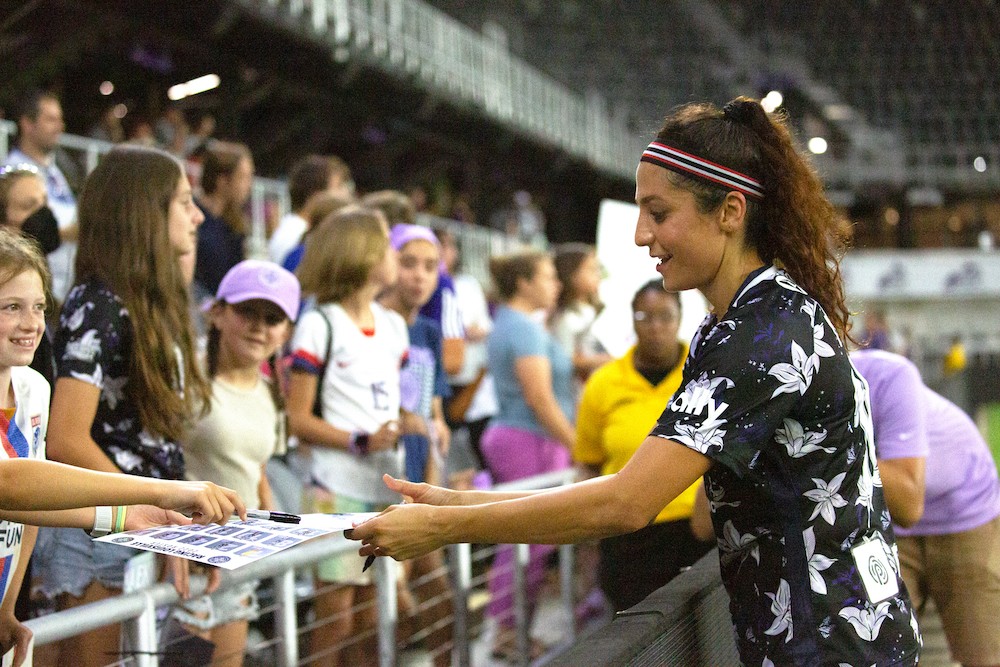
‘Talk To The Doc!’
In a rare weeknight game at home in August, Racing earns a 1-1 draw, largely thanks to the efforts of goalie Katie Lund and the defense holding strong against relentless attacks by the much-better-on-paper OL Reign of Seattle.It’s hot, Racing is near the bottom of the standings and in the upper deck of their Louisville stadium you can catch sniffs of the wafting stench from the nearby JBS meatpacking plant. But the team is playing with heart; Bonner, the English defender, finishes the game with stitches in her head after a first half collision.
Nadim, fresh off of her first full 90-minute game since 2021 four days earlier, came off the bench at halftime to try to break the stalemate. But in a game where they were outshot 25-6, Racing struggled to get the ball to her and other forwards, leading to few good opportunities.
After the final whistle blew without a resolution, players lingered on the field as a few throngs of fans remained in the stands hugging the pitch hoping for an autograph.
While most players signed by the benches and the stairs leading off the field to their locker room, Nadim struck out on her own, walking across the empty pitch to the other side of the stadium where a smaller crowd of home and away fans were gathered.
“Talk to the Doc! Talk to the Doc!” a woman urged (presumably) her children as Nadim approached the stands.
“I live right downstairs from you! We should hang out!” yelled another woman to Nadim before following up with her apartment number and inviting the striker to come by whenever.
Despite her time on the pitch being limited by her injury and recovery, Nadim is a fan favorite. Part of it has to do with how good she is: Despite the late start and limited play time this season, she is the team’s top scorer. But the other part is who she is.
“I think what drew me to Nadia is she has so many similarities to Muhammad [Ali],” says Annie Moore, a board member of the Lou City Ladies supporter group whose favorite player is Nadim (and who, coincidentally, works in communications for the Muhammad Ali Center). “You know, she really stands up for what she believes in. She’s great at what she does on the pitch, but off of it she’s really an advocate for people like her.”
Bringing It All Back Home
On Aug. 15 of last year, the Taliban seized Kabul in the stunning climax of a series of lightning-quick battlefield gains that against a demoralized, unprepared and under-equipped Afghan National Army that, for all intents and purposes, had been abandoned by its American backers.Images of the panicked evacuation of Kabul dominated TV screens and newspaper pages as Afghans tried to get to Kabul’s Hamid Karzai International Airport, the last remaining territory held by the U.S. forces, who had invaded the country nearly 20 years earlier to oust the Taliban after the Sept. 11, 2001 attacks on New York and Washington. The Biden administration had stressed that a Taliban takeover of Afghanistan was not the inevitable result of a U.S. withdrawal, but as U.S. troops left, Taliban forces surged and the Afghan National Army crumbled. Now, tens of thousands of civilians were being evacuated out of the capital packed shoulder-to-shoulder on herculean C-17s. Two people trying to flee fell to their death after trying to stow away in the wheel well of one of the jets in a tragic scene captured on camera. As things fell apart, comparisons to the United States’ hasty 1975 retreat from Saigon were inevitable.
Racing was in New Jersey the day Kabul fell, playing an away game against Gotham FC, Nadim’s old team (though called Sky Blue FC when she played for them). The situation in Afghanistan was on her mind, but she netted a goal in the 13th minute, Louisville’s only score. The game ended in a 1-1 tie.
“Obviously I was upset about the situation, but I’m a professional and I could concentrate on my training and games,” she says. “That said, it was devastating to see how quick the Taliban gained power again.”
Nadim’s aunt, famous Afghan singer Aryana Sayeed, was stuck in Kabul as the Taliban captured the capital, turning Nadim’s WhatsApps with her family into a stream of panicked messages (Sayeed was able to get into the airport and was evacuated to Qatar).
“Seeing what we’ve been working on for 20 years — to escape that regime and try to build the country — just thrown back within one day…That was obviously sad to watch,” says Nadim.
Trying to paint a slightly softer image of themselves this time around, the Taliban said that sports would be allowed, but only for men.
Nadim told me she had hoped to briefly return to Afghanistan in April of last year while filming a French documentary, but that producers pulled the plug after being warned by a diplomat that it could be dangerous for her. With the Taliban in control, Nadim does not know when or if she will be able to see the homeland she escaped more than 20 years ago.
In recent years, scenes of people fleeing war, persecution and collapsed economies have become ubiquitous, with migrants making dangerous crossings of the Mediterranean Sea on overcrowded dinghies and walking thousands of miles towards the southern U.S. border from Central America. Others who did not flee to the West settled down in sprawling refugee camps and slums, sometimes in places only marginally more stable than the homes they had fled.
When Nadim sees those images, she sees herself and what she went through.
“Being a refugee is not something you’re going to be all your life. Just as if you’re homeless: You’re not going to be homeless all your life, you’re just in a situation right now where you’re homeless, you can’t afford to pay your rent or you’ve been fired from your job. It’s kind of the same thing with being a refugee: You’re being forced to lose everything you have and somehow, you need to figure out how to create a new life.”
While it has been popular for right-wing politicians in the U.S. and Europe to use refugees to bait fear and win votes (just see Donald Trump or France’s Marine Le Pen), Nadim hopes instead that people can find empathy for those in the situation that she once was in.
“People have to understand that no human being is going to leave their house or their loved ones or their identity behind to go on this trip where you might lose your life, and end up somewhere where you’re not going to be respected or accepted — forget respected — for who you are as a human being,” she says. “No one wants to do that. The only reason you chose to do it is because you have no other choice, it’s because you are trying to survive.” •
Keep Louisville interesting and support LEO Weekly by subscribing to our newsletter here. In return, you’ll receive news with an edge and the latest on where to eat, drink and hang out in Derby City.
Follow us on Facebook, Twitter and Instagram.

